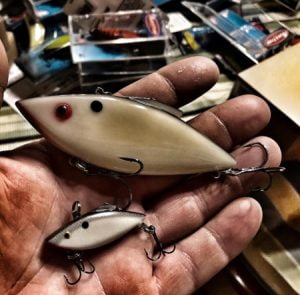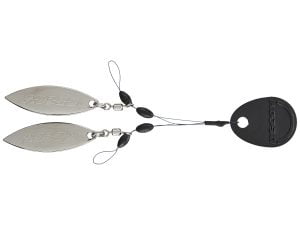Fall Bass Fishing Tips brought to you from ANGLR – the fishing app company.
Lipless Crankbait: Yo-Yoing
When the shad first start to move back into the creeks and pockets, I’ll often encounter them on bluff walls or in the middle of pockets where the water is still 10 to 15-feet deep. Yo-Yoing a lipless crankbait works really well in these situations.
Basically you just want to cast your bait out past the ball of shad and let it sink down below them. Then rip the bait up into the ball of shad and let it sink again. This mimics a struggling shad and is exactly what the bass sitting beneath the ball of bait are looking for.

I’ll typically use a 1/2-ounce lipless crankbait here. You can use a 1/4-ounce but it’s rarely necessary.
Lipless Crankbait: Busting Shallow Bait
As the bass push the bait shallower and shallower, they start to bust them or school on them. That’s when you just want to throw your lipless crankbait past where they’re busting and bring the bait through with a nice steady retrieve. Typically this is happening on a hump, flat or in the back of a pocket so the water is only 1 to 3 feet deep. Because of this, you’ll often need to hold your rod tip up while you reel your bait in and you want to be able to pause the bait or jerk it to give it more action.
However, if you’re doing this across a flat with a pretty good drop on the side, definitely pause your retrieve or ‘kill the bait’ as you reach the deeper water and you’ll often draw a strike there.
Lipless Crankbait: 1/4-Ounce vs 1/2-Ounce
Depending on how shallow you are fishing, a 1/4-ounce lipless crankbait can be much easier to work and more effective than a 1/2-ounce. In addition, there are times when fish will just react better to one or the other so it’s a good idea to have both rigged up.
Sometimes in the fall, matching the hatch is important, so you want to use a 1/4-ounce of 1/2-ounce based on the size of the bait present.
However I’ve also experienced the opposite where there is so much bait present that using a bait that differs slightly in size from the surrounding forage is more effective. Don’t be afraid to try different things if you’re not getting bit. Likewise with color, though typically you want to match the hatch there.
Lipless Crankbait: Lipless with a Blade
 Bill Lewis made a 1/4-ounce Rat-L-Trap with a willow leaf blade where the back hook would typically be and I’ve had a lot of luck with this bait in the fall. It’s not really a bait I fish at all the rest of the year, but when there’s an overabundance of shad I have found that the added flash of the little willow leaf seems to stand out in the crowd well enough to draw a few more strikes.
Bill Lewis made a 1/4-ounce Rat-L-Trap with a willow leaf blade where the back hook would typically be and I’ve had a lot of luck with this bait in the fall. It’s not really a bait I fish at all the rest of the year, but when there’s an overabundance of shad I have found that the added flash of the little willow leaf seems to stand out in the crowd well enough to draw a few more strikes.
I believe this bait may have been discontinued but is easy to duplicate by simply replacing the back treble with a swivel and small willow leaf blade.
Lipless Crankbait Gear
For fishing a lipless crankbait, I prefer a Vursa 7’0” medium heavy paired Lew’s LFS Speed Spool in 7.5:1 and 15-pound fluorocarbon. I might step down to 12-pound test when Yo-Yoing the bait if the fish are a little deeper, but 15-pound is definitely what I go with 95% of the time.
This article was contributed by an ANGLR Expert
Become an ANGLR Expert and apply here.


